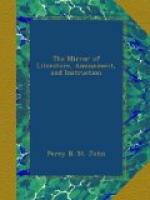“When in danger, cuttle-fish are said to eject a copious black liquor through their funnel or excrementary canal, as a means of obscuring the circumfluent water, and concealing themselves from all foes:—
“Long as the craftie cuttle lieth
sure
In the blacke cloud of his thicke vomiture."[15]
This inky fluid is a very remarkable secretion, produced in a bag that lies near the liver, and sometimes even embosomed in it, and communicating with the funnel by means of its own excretory duct. The interior of the bag is not a simple cavity; it is filled with a soft cellular or spongy substance in which the ink is diffused. This has no relation or analogy with bile, as Munro believed; but it is a peculiar secretion, somewhat glutinous, readily miscible with water, and variable in point of shade, according to the species of cephalopode from which it comes; so that, as Dr. Grant remarks, a more intimate acquaintance with this character might be useful in tracing relations among the different species. The colour of the ink in Loligo sagittata[16] is a deep brown, approaching to yellowish brown when much diluted, and corresponds remarkably with the coloured spots on the skin of that species; but in Octopus ventricosus the colour of the ink is pure black, and it is blackish grey when diluted on paper. “The ink (Edin. Phil. Journ. vol. xvi. p. 316.) brought in a solid state from China has the same pure black colour as in the Octopus ventricosus, and differs entirely in its shade, when diluted, from that of the Loligo sagittata, as may be seen from specimens of these three colours on drawing paper. Swammerdam suspected the China ink to be made from that of the Sepia; Cuvier found it more like that of the Octopus and Loligo; but different kinds of that substance are brought from China, probably made from different genera of these animals, where they abound of gigantic size.” At the present day, according to Cuvier, an ink is prepared from the liquor of these animals in Italy, which differs from the genuine China ink only in being a little less black. (Mem., vol. i. p. 4.) Davy found it to be “a carbonaceous substance mixed with gelatine;” but on a more careful analysis, Signor Bizio procured from it a substance sui generis [peculiar in kind], which he calls melania. “The melania is a tasteless, black powder, insoluble in alcohol, ether, and water, while cold, but soluble in hot water: the solution is black. Caustic alkalies form with it a solution even in the cold, from which the mineral acids precipitate it unchanged. It contains much azote: it dissolves in, and decomposes, sulphuric acid: it easily kindles at the flame of a candle: it has been found to succeed, as a pigment, in some respects better than China ink.” (Edin. Phil. Journ., vol. xiv. p. 376.)




